Dealing with male pattern baldness can be a distressing experience, impacting not just your appearance but also your self-esteem. You are not alone in this journey. With advancements in medical technology, effective solutions are within reach. One such solution is the hair transplant for male pattern baldness. It has gained immense popularity and credibility over the years.
Dr Deepesh Goyal, a prominent plastic surgeon in Jaipur known for his expertise and compassionate approach to patient care, is at the forefront of this life-altering procedure. Operating from Rejuvena Cosmo Care, widely renowned as the best plastic surgery clinic in Jaipur, Dr Goyal and his team provide personalized treatments tailored to meet the unique needs of each facing male pattern baldness.
In this blog, we’ll explore how hair transplant for male pattern baldness can offer a cosmetic fix and a transformative change in life.
First, let’s understand,
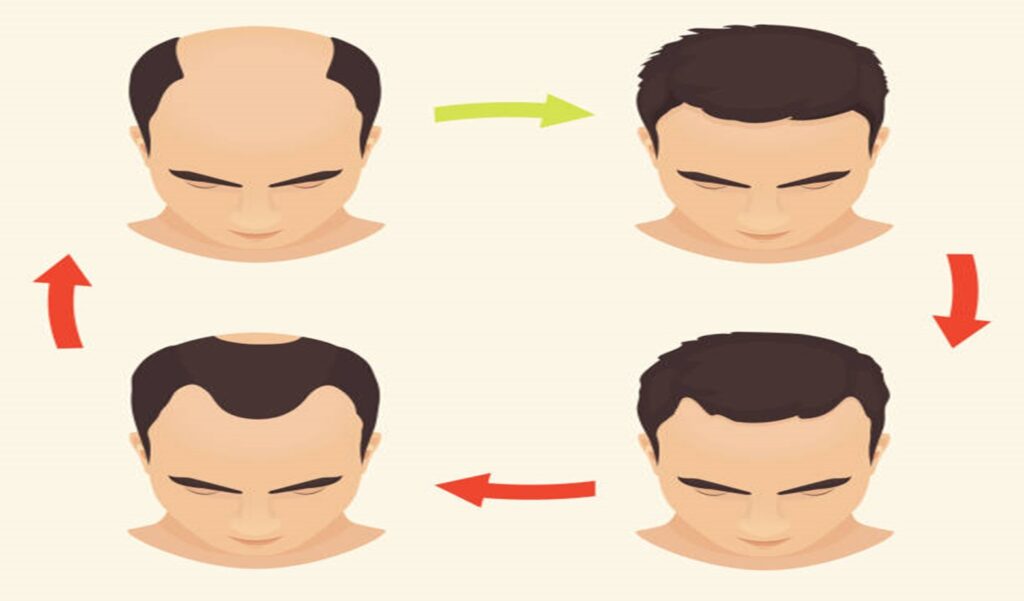
What Exactly is Male Pattern Baldness?
Male pattern baldness, medically known as androgenetic alopecia, is a common form of hair loss in men. This condition typically manifests as a receding hairline and thinning hair on the crown of the head. The root cause of male pattern baldness is a combination of genetics and the hormone dihydrotestosterone (DHT). It causes hair follicles to shrink and eventually stop producing hair.
Statistics reveal that about 50% of men experience some degree of male pattern baldness by the age of 50. The onset can be as early as the late teens or early twenties, with the likelihood increasing with age.
Understanding the progression is crucial.
Let’s delve into the Stages of Male Pattern Baldness
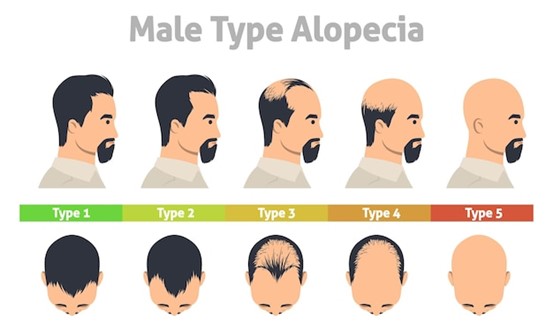
It is essential to understand the stages of male pattern baldness. It typically follows a predictable pattern:
1. Initial Thinning:
The first stage is marked by a slight hairline recession, particularly around the temples. This early sign is often subtle and may be overlooked.
2. Noticeable Recession:
In the second stage, the hairline recession becomes more evident, forming an ‘M’ shape. Thinning at the crown may also begin.
3. Visible Bald Spots:
The third stage is characterized by a more pronounced recession at the temples and noticeable thinning at the crown, leading to visible bald spots.
4. Expanding Bald Areas:
During this stage, the balding areas at the crown and the hairline expand and may begin to join together.
5. Large Bald Areas:
There is significant hair loss at the top of the scalp at this advanced stage. The remaining hair at the sides and back becomes thinner and weaker.
6. Extensive Baldness:
In the final stage, the bald area covers a large portion of the head, with the horseshoe-shaped hair pattern being the most common residual hair formation.
Now, let’s explore the solution that brings back not just hair but also hope.
Overview of Hair Transplantation
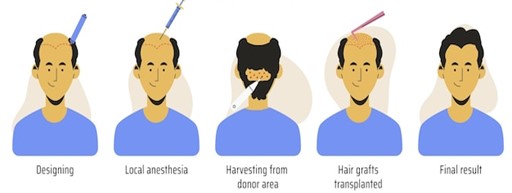
Hair transplant is a minimally invasive hair restoration technique. It involves moving hair follicles from a part of the body, typically the back or sides of the scalp, to the balding or thinning areas. This procedure is a highly effective option for hair restoration for male pattern baldness. Research shows a high satisfaction rate, with around 80% of men pleased with the outcomes.
Ready to transform your look with a hair transplant in Jaipur? Schedule an appointment with Dr. Deepesh Goyal and take the first step towards a fuller head of hair.
Embarking on the hair transplant journey? Here’s what to expect.
Steps Involved in Hair Transplant Procedure
1. Consultation and Planning:

The first step involves consulting with a hair transplant specialist. They assess your scalp, discuss expectations, and plan the procedure.
2. Preparation:
Before the procedure, the surgeon cleans the scalp. Then, they administer local anesthesia to numb the treatment area.
3. Extraction of Hair Follicles from Donor Area:
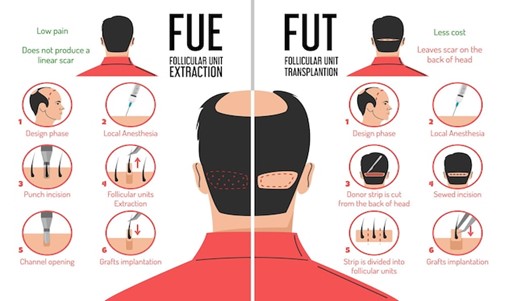
The most common techniques employed for harvesting hair follicles from donor site includes:
FUE: It involves extracting individual hair follicles directly from the scalp and placing them in the recipient area.
Click here to learn more about FUE hair transplant in Jaipur.
FUT: This method entails removing a strip of skin with hair from the scalp and extracting follicles from this strip.
4. Graft Preparation:
The surgeon prepares the extracted follicles under a microscope. They ensure the follicles are in optimal condition for transplantation.
5. Recipient Site Creation:
The surgeon creates small incisions in the balding areas of the scalp for placing the hair follicles.
6. Transplantation:
The hair transplant surgeon inserts the prepared follicles into the incisions. This step requires precision to ensure a natural-looking hairline and density.
7. Post-Procedure Care:
After the transplant, the scalp is bandaged. The post-operative care instructions are given to promote healing and optimal results.
8. Recovery:
Initial healing takes a few days, and full recovery can take a few weeks. Transplanted hair falls out initially, with new growth starting in a few months.
9. Follow-Up:
Regular follow-up appointments are essential to monitor the progress and address any concerns.
Seeking the best FUT hair treatment in Jaipur? Visit Rejuvena Cosmo Care and discover the gold standard in FUT hair transplant in Jaipur.
Treatment Options for Male Pattern Baldness Other Than Hair Transplant
Hair transplant is among the most effective hair restoration options for male pattern baldness. Yet, there are several non-surgical treatment options available.
1. Minoxidil Application:
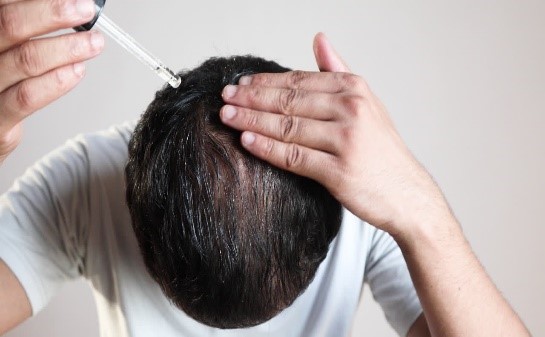
Minoxidil, an over-the-counter topical treatment, is widely used. It is applied directly to the scalp and is known for its effectiveness in stimulating hair growth.
2. Finasteride Pills:
Finasteride, an oral medication, effectively slows hair loss. It works by blocking the hormone responsible for male pattern baldness.
3. PRP Hair Therapy:
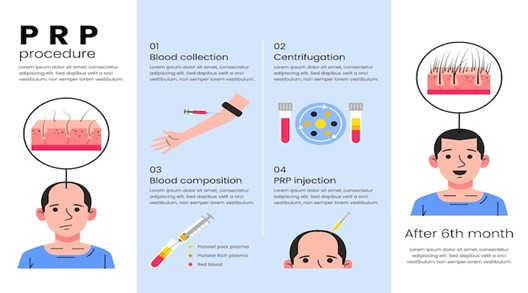
Platelet-rich plasma (PRP) hair therapy is a non-surgical medical treatment for hair loss. It involves injecting a concentration of a patient’s platelets, extracted from their blood, into the scalp. This process stimulates hair growth by encouraging the rejuvenation of hair follicles.
4. Low-Level Laser Therapy (LLLT):
LLLT uses laser light to encourage hair growth. It is a non-invasive option, gaining popularity for its ease of use and effectiveness.
Each treatment has its merits, and suitability varies per individual. Consulting with a hair specialist like Dr. Deepesh Goyal is crucial to determine the best course of action for your case.
Now, let’s discuss about,
Cost of Hair Transplant and Other Treatment for Male Pattern Baldness
Understanding the cost of different treatment options for male pattern baldness is crucial. The hair transplant price in Jaipur can vary based on several factors. These include the clinic’s reputation, the doctor’s experience, and the patient’s needs.
Here’s an approximate cost breakdown and number of sessions required for different treatments:
| Treatment Option | Approximate Cost per Session (INR) | Sessions Required |
| Medication | 500 – 2,000 (monthly) | Ongoing |
| PRP Therapy | 4,000 – 15,000 | 3-6 |
| Hair Transplant (FUT/FUE) | 30,000 – 1,00,000 | 1-2 |
| Laser Therapy | 5,000 – 10,000 | 5-10 |
Consult with a medical professional to determine the best course of action for individual cases of male pattern baldness. Prices may vary based on specific circumstances and additional care needs.
For the most accurate information, a consultation with a skilled specialist like Dr Deepesh Goyal, a renowned hair transplant surgeon in Jaipur, would be advisable.
Click here to know the hair transplant cost in Jaipur.
Curious about when you’ll start seeing the results? Let’s find out.
When to Expect the Results?
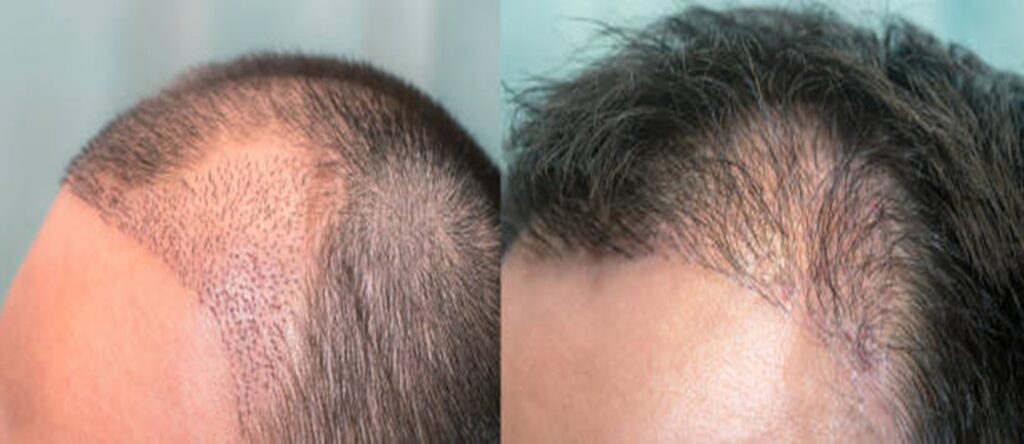
Regarding the timeline for seeing results after a hair transplant, patients can typically expect the following:
- Initial Growth Phase:
Patients may notice the initial growth of transplanted hair within the first two to three months post-surgery. It is essential to understand that this early growth might appear uneven or sparse.
- Noticeable Results:
Significant and more uniform hair growth usually becomes visible around the six-month mark. This is when patients can start appreciating the changes and improvements in their hairline or balding areas.
- Full Results:
A hair transplant’s complete and final results are generally observed 12 to 18 months after the procedure. By this time, the transplanted hair has fully matured. They blend seamlessly with the existing hair and provide a natural and fuller appearance.
It is essential to note that individual results may vary based on factors such as the patient’s health, the extent of baldness, and the hair transplant technique used.
Ready to see the transformation for yourself?
Let’s Discuss Before and After Results
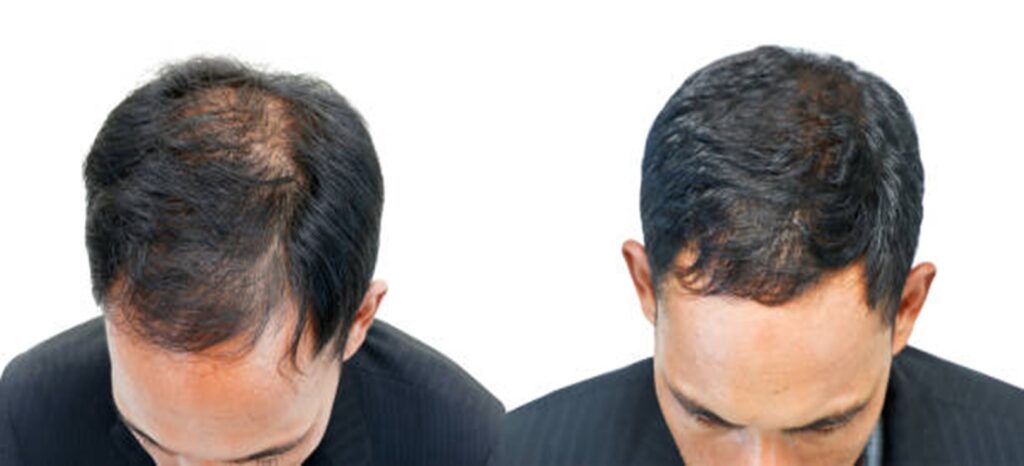
The results before and after the procedure are not just about hair regrowth. They represent a journey towards renewed self-confidence and a restored appearance. Post-hair transplant, the results can be life-changing. Most patients observe noticeable hair growth within 3 to 6 months after the surgery, with the full effects typically visible after 12 to 18 months.
The success rate of hair transplants can be as high as 95%, depending on the surgeon’s skill and the patient’s health. This high success rate underlines the procedure’s effectiveness.
Choosing a skilled and experienced surgeon like Dr. Deepesh Goyal is crucial. The surgeon’s expertise plays a pivotal role in determining the outcome of the hair transplant. Dr. Goyal’s proficiency ensures that each follicle is strategically placed to mimic natural growth patterns, thereby promising hair regrowth and a natural, aesthetically pleasing appearance.
Navigating the aftercare journey is just as important as the procedure itself.
Let’s Unwrap the Essentials of Post-transplant Care
After any medical procedure, the journey to recovery hinges significantly on effective aftercare. This aspect of treatment, often underrated, is crucial in ensuring successful outcomes and minimizing complications.
Critical Elements of Aftercare
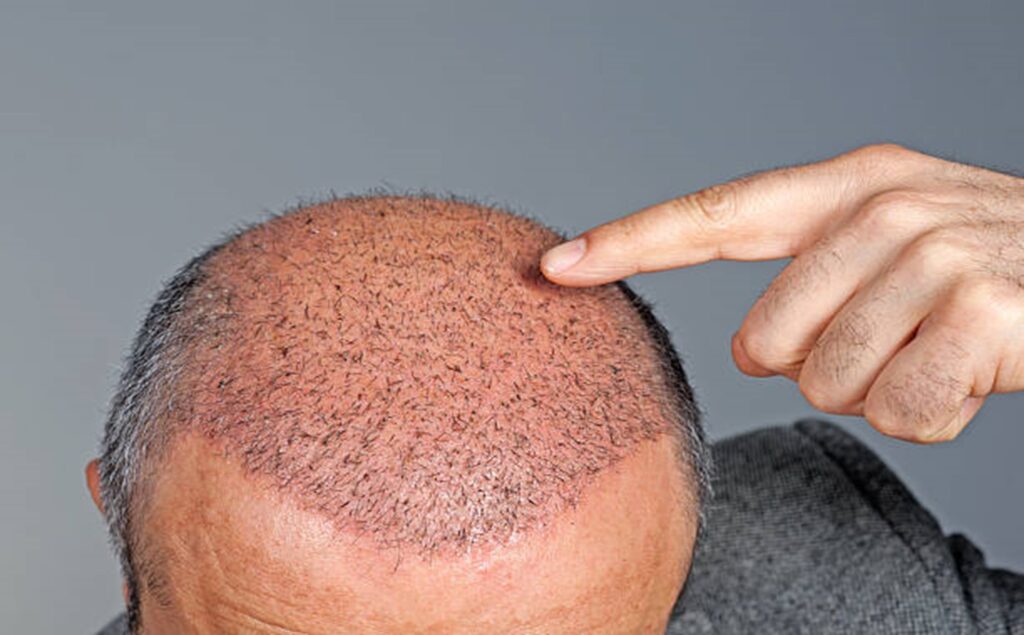
1. Follow-up Appointments:
Post-procedure, it is crucial to attend all follow-up appointments. This practice allows doctors to monitor recovery progress and promptly address concerns.
2. Adhering to Medication Protocols:
Patients should strictly follow the prescribed medication schedule. Whether for pain management or preventing infections, this step is non-negotiable for a smooth recovery.
3. Rest and Recovery:
The body needs time to heal. Patients should rest adequately and avoid strenuous activities that might hinder recovery.
4. Nutrition and Hydration:
A balanced diet and proper hydration are vital to accelerating healing. Nutrient-rich foods fortify the body and support tissue repair.
Conclusion
Hair transplant for male pattern baldness have emerged as a highly effective solution. This procedure, mainly when performed by skilled professionals like Dr. Deepesh Goyal in Jaipur, offers a promising path for those struggling with hair loss.
Dr. Goyal’s expertise, combined with the advanced techniques at Rejuvena Cosmo Care, a leading hair transplant clinic in Jaipur, ensures a high satisfaction rate among patients.
Embracing this procedure can improve hair density and enhance self-confidence and quality of life. Consulting with a qualified professional is crucial for individuals considering a hair transplant to understand the best approach tailored to their needs.
FAQs:
How Long Does a Hair Transplant Last for Male Pattern Baldness?
A hair transplant can be a lasting solution for male pattern baldness. Typically, the results are permanent. The transplanted hair follicles are resistant to the balding process. However, remember, it doesn’t stop new balding or thinning. So, you might need future treatments for other areas.
Is a Hair Transplant Painful?
The procedure involves local anesthesia, meaning you will be awake but not feel any pain in the treatment area. Post-surgery, you might experience some discomfort. However, it is often manageable with prescribed pain relief.
How Soon Will I See Results from a Hair Transplant?
Patience is vital with hair transplants. Initially, the transplanted hair will fall out — this is normal. Real growth starts around three to four months after surgery. For the full effect, you will likely wait six to twelve months. So, hang in there; the results take time but are worth it.
Reference links:
https://www.webmd.com/skin-problems-and-treatments/hair-loss/hair-transplants

